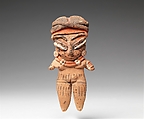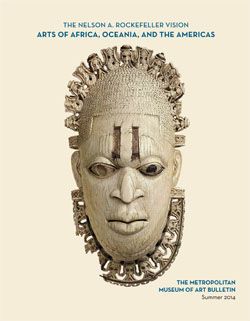Female Figure
Not on view
Thousands of small ceramic figurines between 1 1/2 to 6 inches tall have been made by most ancient peoples in Mesoamerica from as early as the second millennium B.C. to the time of the Aztec in the early sixteenth century. They were placed with the dead in burials together with other funerary offerings. Mostly hand-modeled, the figurines are predominantly female and come in a variety of styles displaying regional characteristics such as the coffee-bean eyes typical of figurines from Chupicuaro. The figurines are usually nude, have elaborate coiffures, and often wear ear, neck, and arm ornaments as seen here. Some link the figurines to fertility cults; others view them simply as companions for the dead.
In the early 1950s, as Nelson Rockefeller and René d'Harnoncourt continued to buy "primitive" works of art, offers from private individuals came their way. This small female figure, along with with three others also on view, was offered to them by Esther Scheinman of Brooklyn. She introduced herself by writing that she had met Nelson's father at Joseph Brummer's, a New York dealer with whom she worked for more than twenty years. While at Brummer's she had taken the opportunity to buy a number of Mexican ceramic figurines from one of Brummer's "principal sources." Rockefeller bought forty early Mexican figurines from Esther Scheinman in 1951.
Due to rights restrictions, this image cannot be enlarged, viewed at full screen, or downloaded.


